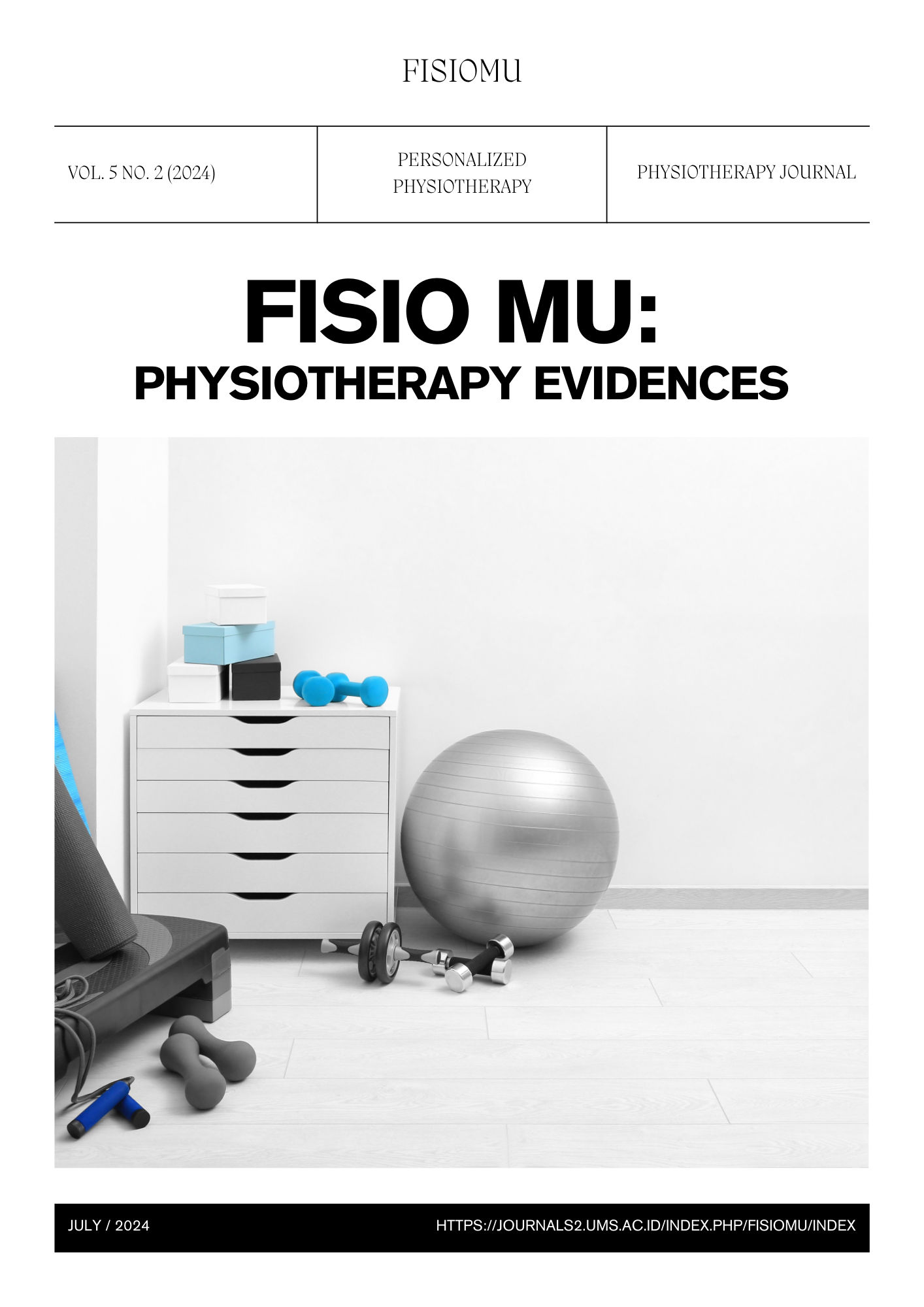Implementation Of Gaze Stability Exercise With Ergonomic Approach Based On Home Training Program in Improving Balance in The Elderly
DOI:
https://doi.org/10.23917/fisiomu.v5i2.4164Keywords:
Balance, Elderly, Ergonomics, Gaze Stability ExerciseAbstract
Introduction: The aging process is characterized by a decrease in physiological function, which has an impact on balance disorders and can increase the risk of falling in the elderly. Purpose: This study was to analyze differences in the balance of the elderly before and after the implementation of gaze stability exercise with an ergonomic approach based on a home exercise program. Methods: This research is an experimental study with a pre and post test one group design. Participants underwent training every day for 6 weeks. Balance ability was measured using time up and go test pre and post intervention. Results: There was a significant difference in the pre and post intervention time up and go test scores with p < 0.05. Conclusion: based on the results of the study, the implementation of gaze stability exercise with an ergonomic approach based on a home exercise program was significant in improving the balance of the elderly by 18.6% compared to before receiving the exercise.
Keywords: Balance, Elderly, Ergonomics, Gaze Stability Exercise
Downloads
References
Bhardwaj, V. and Vats, M., 2014. Effectiveness of Gaze Stability Exercises on Balance in Healthy Elderly Populatione. International Journal of Physiotherapy and Research, 2: 642–689.
Driessen, M., Proper, K., Anema, J., Bongers, P. and Beek, A., 2010. Process Evaluation Of A Participatory Ergonomics Programme To Prevent Low Back Pain And Neck Pain Among Workers. Implementation Science, 5: 1–11.
Fatima, S. N., Tanveer, F., Shoukat, F., Ahmad, A. and Siddique, K., 2022. Effects Of Balance Training With And Without Gaze Stabilization Exercises On Clinical Outcomes In Elderly Patients With Chronic Dizziness: A Randomized Controlled Trial. Journal Of Bodywork and Movement Therapies, 32: 46–50.
Gaikwad, S. B., Johnson, E. G., Nelson, T. C., Ambode, O. I., Albalwi, A. A., Alharbi, A. A. and Daher, N. S., 2018. Effect of Gaze Stability Exercises on Chronic Motion Sensitivity: A Randomized Controlled Trial. Journal of Neurologic Physical Therapy, 42: 72–79.
Kementerian Kesehatan, 2017. Kementerian Kesehatan Republik Indonesia: Analisis Lansia di Indonesia. Jakarta Selatan: Pusat Data dan Informasi.
Khanna, T. and Sandeep, S., 2014. Effect of Gaze Stability Exercises on Balance in Elderly. Journal of Dental and Mdical Sciences, 12: 41–48.
Limerick, R. B., 2018. Participatory Ergonomics: Evidence And Implementation Lessons. Applied Ergonomics, 68: 289–293.
Matsugi, A., Ueta, Y., Oku, K., Okuno, K., Tamaru, Y., Nomura, S., Tanaka, H. and Mori, N., 2017. Effect Of Gaze-Stabilization Exercises On Vestibular Function During Postural Control. NeuroReport, 28: 439–443.
Papa, E. V, Dong, X. and Hassan, M., 2017. Skeletal Muscle Function Deficits in the Elderly: Current Perspectives on Resistance Training. J N Sci, 3: 1–8.
Roh, M. and Lee, E., 2019. Effects Of Gaze Stability Exercises On Cognitive Function, Dynamic Postural Ability, Balance Confidence, And Subjective Health Status In Old People With Mild Cognitive Impairment. Journal of Exercise Rehabilitation, 15: 270–274.
Suhardi, B., Citrawati, A. and Astuti, R. D., 2021. Ergonomi Partisipatori Implementasi Bidang Kesehatan Dan Keselamatan Kerja (1st Edition). Yogyakarta: Deepublish.
Tappin, D. C., Vitalis, A. and Bentley, T. A., 2016. The Application Of An Industry Level Participatory Ergonomics Approach In Developing MSD Interventions. Applied Ergonomics, 52: 151–159.
Ueta, Y., Matsugi, A., Oku, K., Okuno, K., Tamaru, Y., Nomura, S., Tanaka, H., Douchi, S. and Mori, N., 2017. Gaze Stabilization Exercises Derive Sensory Reweighting Of Vestibular For Postural Control. Journal of Physical Therapy Science, 29: 1494–1496.
Vittala, G., Sundari, L. P. R., Basuki, N., Kuswardhani, R. . T., Purnawati, S. and Muliarta, I. M., 2021. The Addition of Active Stretching to Balance Strategy Exercise is the Most Effective as a Home‑Based Exercise Program in Improving the Balance of the Elderly. Journal of Mid-Life Health, 12: 294–298.
Downloads
Submitted
Accepted
Published
How to Cite
Issue
Section
License
Copyright (c) 2024 Fisio Mu : Physiotherapy Evidaces Journal

This work is licensed under a Creative Commons Attribution-NonCommercial-NoDerivatives 4.0 International License.

This work is licensed under a Creative Commons Attribution-NonCommercial 4.0 International License.
Authors who publish with FISIO MU: Phsiotherapy Evidences agree to the following terms:
- Author(s) retain copyright and grant the journal right of first publication with the work simultaneously licensed under a Creative Commons Attribution-NonCommercial 4.0 International License that allow others to share the work within an acknowledgement of the work’s authorship and initial publication of this journal.
- Author(s) are able to enter into separate, additional contractual arrangement for the non-exclusive distribution of the the journal’s published version of the work (e.g. acknowledgement of its initial publication in this journal).
- Author(s) are permitted and encouraged to post their work online (e.g. in institutional repositories or on their websites) prior to and during the submission process, as it can lead to productive exchanges, as well as earlier and greater citation of published works.









